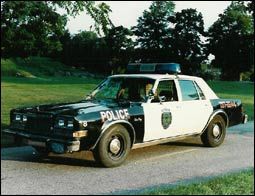Law enforcement is a profession of trends and traditions. Few traditions are more identifiable than the black and white police car. In the 90’s, agencies that once sported black and white cars began converting to solid white, green or blue. In recent years, black-and-whites have made a comeback, and street officers are rejoicing.
 |
Black and white was not always the tradition. As police vehicles became a mainstay in the United States, most of them were a solid color. In an effort to stand out from the general civilian car, many departments utilized a black car and simply added a white stripe. Ford started making extra-durable police package cars in 1950, and the black and white paint scheme soon followed. By the1960’s, black-and-whites were everywhere, further mythologized by TV police shows like Adam 12 and Andy Griffith.
In the 1990’s, many departments converted to solid-colored cars. As local governments battled increasing demands and lower budgets, the traditional black and white was eliminated in favor of cost-efficient solids. White cars soon became standard. Emblems that had often been simplified for the readily recognizable black and white scheme often were now embelleshed and enlarged so citizens could recognize white cars as police cars.
But in the past few years, the trend has reversed. Black and white is making a comeback. Cost is no longer a prohibitive factor. Manufacturers, aware of agency constraints, quote less than a $500 increase for each car with the traditional paint job. Cash-strapped police departments around the country are getting creative with their bottom line: Mesa, Arizona purchased smaller hubcaps to offset the $400 increase; Fond du Lac, Wisconsin offset $300 each by opting for a less complicated graphics package. With a few pocket windfalls and overwhelming enthusiasm, the popularity of black and white cars is approaching an all-time high.
But why bring them back? Public recognition tops the list. For instance, the concept of community policing relies heavily on the active participation of citizens to solve community-wide problems. The street officer must maintain a high degree of visibility in order to collaborate and build relationships with these citizens. To this end, having a recognizable police vehicle makes a lot of sense.
Captain Tim Johnson of the Sunnyvale (CA) PD has done extensive research on this topic. He finds that, not only does the public have a positive response to black and white cars, but that officers who drive them are seen as more approachable. Indeed, recent surveys suggest that nearly every department using black and white cars cite increased visibility and accessibility as the main selling points.
Other factors are cited, as well. When the Costa Mesa (CA) PD began reverting to black and white cars in 2004, the public began asking if more cops were on the streets. Lieutenant Karl Schuler of Costa Mesa believes that the traditional look is a great way to make the community feel more secure. In fact, the Winnemucca, Nevada PD credits their black-and-whites with not only giving the appearance of more officers, but also reducing certain crimes in their small town.
With the traditional look, it appears that an increase in officer morale follows. Officers from across the country have overwhelmingly supported a change to black and white cars. A recent vote in a large Midwest municipal police department revealed that 83% of the officers were strongly in favor of transitioning to a black and white vehicle. The popularity of black and white cars by the officers has a positive impact on any administrator that chooses to make the change.
Ed Nowicki, the Executive Director of the International Law Enforcement Educators and Trainers Association (ILEETA), is a proponent of a unilateral switch. “A black and white car would clearly represent law enforcement in the same manner that people know that fire trucks are red,” he says. Mr. Nowicki emphasizes that a standard LE vehicle would not only help prevent the impersonation of an officer, but would also give citizens the added comfort of seeing a “united front” in law enforcement.
Whether it is community relations, better visibility, tradition or perception, black and white police cars appear, once again, to be making their cultural mark on American law enforcement. In the fast-paced, technology-driven police culture, the simple tradition of a black and white car is a welcome sight.
Captain Travis Yates commands the Precision Driver Training Unit with the Tulsa, Okla. Police Department. He is a nationally recognized driving instructor and a certified instructor in tire deflation devices and the pursuit intervention technique. Capt. Yates has a Master of Science Degree in Criminal Justice from Northeastern State University and is a graduate of the FBI National Academy. He moderates www.policedriving.com, a website dedicated to law enforcement driving issues. He is available for consulting and may be reached at policedriving@yahoo.com.


